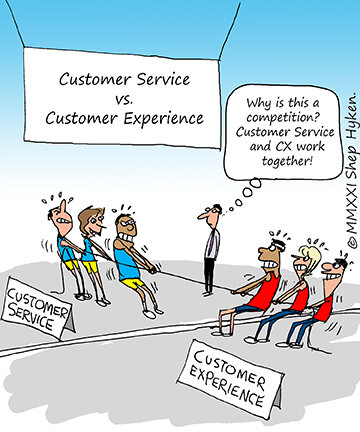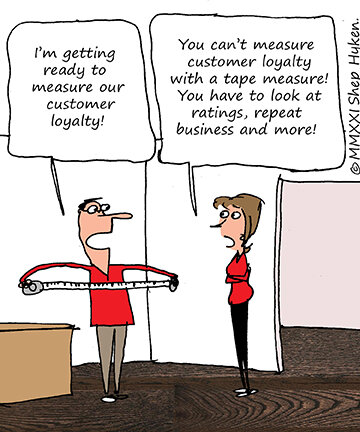
Sound Wisdom Blog
How to Handle Difficult Customers by Shep Hyken
Not long ago I covered six ways to handle angry customers. Often an angry customer and a difficult customer are the same. But that’s not always true. Sometimes difficult customers aren’t angry. They are just tough and demanding. That said, the techniques I cover in both of these posts can work, with a little tweak or variation depending on the situation. So, after you read this, I urge you to go back and read the original article. This is a follow-up with another half dozen techniques to manage angry and/or difficult customers.
Photo by ahmad gunnaivi on Unsplash
Not long ago I covered six ways to handle angry customers. Often an angry customer and a difficult customer are the same. But that’s not always true. Sometimes difficult customers aren’t angry. They are just tough and demanding. That said, the techniques I cover in both of these posts can work, with a little tweak or variation depending on the situation. So, after you read this, I urge you to go back and read the original article. This is a follow-up with another half dozen techniques to manage angry and/or difficult customers.
So, here are six ways to handle difficult customers:
Avoid acting indifferent toward your customer. Customers want your attention, and they want to feel as if the relationship you have with them is important. Indifference is apathy. That will never make a customer happy.
Ask the right questions. These are the appropriate questions that give you the answers to understand the situation. But be careful about interrupting with questions. That can frustrate the customer. There may be a time you need to interrupt, but just go about it the right way. Cutting the customer off could end up escalating the anger or problem, when it’s your intention to do the opposite.
Empathize! This has become a very popular word. Customers want you to empathize and understand their situation. The old expression about putting yourself in the customer’s shoes comes to mind. Saying something like, “I know how you feel. I would feel the same way if that happened to me,” could help customers know you’re on their side.
Don’t tell the customer he or she is wrong. This isn’t about who is right or who is wrong. This is about getting the customer to say, “Thanks for taking great care of me.” You’re not going to get there if you’re accusing the customer of being wrong. Remember one of my favorite sayings: The customer is not always right! But when they are wrong, let them be wrong with dignity and respect.
Don’t blame others inside your company. Never make anyone in your organization look bad. When a problem comes your way, you own it, regardless of who is at fault.
Focus on a positive outcome. Instead of focusing on what you can’t do, focus on what you can do. Customers want to know they are talking to someone who can solve their problems.
So, there are six more tips on how to handle difficult and angry customers. In any given situation, one or more of these tactics may come in handy. Remember, you’re trying to get the customer to come back. As you interact with them, ask yourself, “Is what I’m doing right now going to make my customer come back the next time they need what we sell?”
Shep Hyken is a customer service expert, keynote speaker, and New York Times bestselling business author. His latest book, I’ll Be Back: How to Get Customers to Come Back Again and Again, is available now from Sound Wisdom. For information, contact 314-692-2200 or www.hyken.com. For information on The Customer Focus™ customer service training programs, go to www.thecustomerfocus.com. Follow on Twitter: @Hyken. This post originally appeared here on Shep Hyken’s Customer Service Blog.
Customer Service versus Customer Experience…What’s the Difference? by Shep Hyken
“Customer service is not a department that deals with problems and complaints. It’s a philosophy to be embraced by every employee.”
Some say that customer service is what happens when the customer experience goes wrong.
That’s part of it, but it’s not the whole picture. If you’ve followed my work, you know that customer service is not a department that deals with problems and complaints. It’s a philosophy to be embraced by every employee, from the CEO or owner to the most recently hired. It’s how you interact with people, both your internal and external customers.
Photo by Christiann Koepke on Unsplash
It is one of the most common questions I’m asked in interviews: What’s the difference between customer service and customer experience (also known as CX)?
While I’ve written about this before, my original article about customer experience was more about how to create a more interactive experience. The example I used was how Home Shopping Network (HSN) incorporated gamification into the customer experience. It offered games and puzzles on its website. The prize for winning the game or solving the puzzle was in the form of discounts. That’s a great—and even fun—experience, but there is much more to it than that.
First, a little history. I remember the term “customer experience” being used as a fancy phrase to describe customer service. Many years ago, that’s all it was. Some smart person was trying to give a facelift to the term “customer service.” Not long after that, however, other smart people started using the term “customer experience” to describe every interaction with a company. That included customer service and much more.
This is where it confuses some people. Customer service is part of customer experience, but customer experience goes to a much broader level. Some of the obvious experiences include navigating a website, reading promotional emails and text messages, watching the brand’s videos, and much more. Even opening a package is part of the customer experience. Think about how cool it is to unbox an iPhone or iPad. Back in the day, Steve Jobs was very specific about how he wanted the unboxing of the company’s products to be an amazing CX.
“Customer service is not a department that deals with problems and complaints. It’s a philosophy to be embraced by every employee.”
Some say that customer service is what happens when the customer experience goes wrong.
That’s part of it, but it’s not the whole picture. If you’ve followed my work, you know that customer service is not a department that deals with problems and complaints. It’s a philosophy to be embraced by every employee, from the CEO or owner to the most recently hired. It’s how you interact with people, both your internal and external customers.
The customer support department deals with questions, problems, and complaints. Of course, their customer service skills must be at the highest level when dealing with unhappy customers and solving problems.
So, a short definition of customer service is all of the interactions that customers have with the people in the company. We can even broaden that to digital interactions, which now include chatbots, interactive experiences on a website, and more. Just to emphasize, these interactions include, but go beyond, the interactions for customer support.
Customer experience includes customer service—and everything else a customer might experience when doing business with you.
Shep Hyken is a customer service expert, keynote speaker, and New York Times bestselling business author. His latest book, I’ll Be Back: How to Get Customers to Come Back Again and Again is available for preorder at www.IllBeBackBook.com. For information, contact 314-692-2200 or www.hyken.com. For information on The Customer Focus™ customer service training programs, go to www.thecustomerfocus.com. Follow on Twitter: @Hyken. This post originally appeared here on Shep Hyken’s Customer Service Blog.
Companies’ Responses to COVID Provide Insights into Handling a Crisis by Shep Hyken
During tough times of any type, certain businesses struggle. The first reaction of many is to tighten expenses and reduce employees. Some go out of business. Then there are certain industries that may not be impacted. For example, during the pandemic, grocery stores flourished. Certain online retailers, like Amazon, had a banner year. And there are companies that you think would have been impacted, but somehow they did well—and continue to do so.
Photo by krakenimages on Unsplash
One of our readers asked me the following question: What is your advice for a company that is struggling during COVID-19?
I know, we’re all tired of hearing about COVID-19 and the pandemic. However, there is light at the end of this very dark tunnel. We are seeing business in most industries returning to pre-pandemic levels. Still, some companies are still struggling. While some industries and companies flourished throughout the last year, many were forced to a level of flexibility that included major changes, just to barely survive and keep their doors open.
With that said, the answer I’m about to give applies not only to the last year and COVID-19, but also any time a business experiences negative national and world events, including economic downturns, terrorism, and yes, even global pandemics.
During tough times of any type, certain businesses struggle. The first reaction of many is to tighten expenses and reduce employees. Some go out of business. Then there are certain industries that may not be impacted. For example, during the pandemic, grocery stores flourished. Certain online retailers, like Amazon, had a banner year. And there are companies that you think would have been impacted, but somehow they did well—and continue to do so.
So, consider all of that as I share an answer to the original question, which was advice for businesses struggling during COVID-19.
Start by getting a team together to strategize and share ideas. The conversation should begin with a discussion about the companies you believe had success throughout the pandemic. Again, this could be any major downturn in business due to outside and unforeseen circumstances. What did they do, if anything, that was different than they had done before the pandemic? What do you like—or not like—about the changes they made?
Then determine if any of these changes can work for your company. It doesn’t have to be exactly the same. Let this list serve as a catalyst to jumpstart creativity to come up with a list of ideas that might work for you. Then once you’ve created this list, don’t just look at it. Work it! Make it happen. The adoption of ideas from the success of others outside of your industry can make you more competitive inside your own industry.
This is a very short answer to a very big question. And it’s not the only answer. So if you have another answer, we would all love to hear from you. Feel free to share!
Shep Hyken is a customer service expert, keynote speaker, and New York Times bestselling business author. His latest book, I’ll Be Back: How to Get Customers to Come Back Again and Again is available for preorder at www.IllBeBackBook.com. For information, contact 314-692-2200 or www.hyken.com. For information on The Customer Focus™ customer service training programs, go to www.thecustomerfocus.com. Follow on Twitter: @Hyken. This post originally appeared here on Shep Hyken’s Customer Service Blog.
The Most Important Measurement in Business by Shep Hyken
It’s important to know how customers feel about the experience they just had. We should always be looking at those experiences and finding ways to make them better. Feedback and ratings will help drive that effort. But in the end, knowing what percentage of customers come back, how often they come back, and how much they buy when they do come back, is a metric to pay close attention to.
Photo by Blake Wisz on Unsplash
This is the first of a number of lessons I’ll be sharing from my newest book, I’ll Be Back: How to Get Customers to Come Back Again and Again. A few years back I wrote about the idea of measuring customer satisfaction versus customer behavior. We’re revisiting that topic with a fresh point of view.
Today’s lesson is about the exciting topic of measurement and data. Okay, maybe not that exciting, but how about very important? You know it is! Business management guru Peter Drucker said, “You can’t manage what you don’t measure.”
So, what should we be measuring? What’s the best metric? Why do our customers come back? There are a number of ways organizations measure customer satisfaction. By the way, I don’t like that word, satisfaction. The word satisfactory implies everything is okay, average, or fine. If you asked someone to rate you as either poor, satisfactory, or excellent, you can see that satisfactory is in the middle. Again, just average. But, back to the point. Call it customer satisfaction, customer happiness, or anything you want. The important idea to remember is that we’re looking at ratings.
As an example, two very popular measurements are NPS (Net Promoter Score) and CSAT (Customer Satisfaction). Both give you an idea of how happy the customer is. But, you need to know more. When you ask marketing and customer service experts what they monitor, you’ll likely hear about similar satisfaction or happiness measurements. You’ll also hear them talk about sales numbers, profit, revenue, and other indications that the company is doing well—or not so well.
But another measurement I suggest companies pay close attention to, in addition to those just mentioned, is this one: Does the customer come back?
That’s not a rating. That’s behavior! Big difference. Your customers can rate you five out of five stars and give you glowing reviews. But what if they don’t come back? The ratings and reviews were nice, but the opportunity to do more business vanishes if they don’t return.
It’s important to know how customers feel about the experience they just had. We should always be looking at those experiences and finding ways to make them better. Feedback and ratings will help drive that effort. But in the end, knowing what percentage of customers come back, how often they come back, and how much they buy when they do come back, is a metric to pay close attention to.
If getting your customers to come back, again and again, is important to you, and you know it is, you’ll love the book. Just go to www.IllBeBackBook.com.
Shep Hyken is a customer service expert, keynote speaker, and New York Times bestselling business author. His latest book, I’ll Be Back: How to Get Customers to Come Back Again and Again is available for preorder at www.IllBeBackBook.com. For information, contact 314-692-2200 or www.hyken.com. For information on The Customer Focus™ customer service training programs, go to www.thecustomerfocus.com. Follow on Twitter: @Hyken. This post originally appeared here on Shep Hyken’s Customer Service Blog.
Here’s How to Get Customers to Say, “I’ll Be Back!” by Shep Hyken
Many companies think they have to compare themselves to their competition. They want to know what the competition is doing that they are not. And when they figure it out, you know what they do? They copy them.
It’s not a bad idea to do that, but it’s not the best idea either. If all you do is compare yourself to your competitors, you may be missing your best opportunities to create the best experience for your customers.
Photo by Patrick Tomasso on Unsplash
Many companies think they have to compare themselves to their competition. They want to know what the competition is doing that they are not. And when they figure it out, you know what they do? They copy them.
It’s not a bad idea to do that, but it’s not the best idea either. If all you do is compare yourself to your competitors, you may be missing your best opportunities to create the best experience for your customers.
In my newest book, I’ll Be Back: How to Get Customers to Come Back Again and Again, I cover a six-step process to getting your customers to say, “I’ll be back.” I’m going to summarize the process here. It’s not complicated. It’s actually pretty simple, but that doesn’t mean it’s easy. So let’s jump right into it.
Start by calling a meeting. In all, it will probably take at least two or three meetings. Leadership should be there, along with other employees with varied responsibilities, from sales, support, finance, and more.
Step One: Ask yourself and the team, “Why should people do business with us?” Answers like, “We have great customer service” are too vague and also something the competition is likely to say. Get specific and think of what you offer that makes you unique.
Step Two: Check out the competition. What do they do that you don’t? Is this something you could be doing? Look for ways they differentiate themselves from what you do.
Step Three: Keep pace. If you discover things that the competition is doing that you’re not, and you decide you want to do something similar, don’t just copy their ideas. Give them a twist and make them your own. If you copy them, you’ll be just like them. And if all you are is a copy of the competition, you are a commodity.
If all you are is a copy of the competition, you are a commodity.
Step Four: Move beyond your industry. Ask the team, “What companies, not including the competitors, do you like doing business with the most, and why?” Any type of company counts small, big, recognizable brands, and more. List reasons you like them and get ready for the next step.
Step Five: Borrow from the best. Looking at the reasons you like the companies listed in Step Four, make note of what these companies do that you don’t, but could. This is a powerful way to create even more distance from your competition.
Step Six: Revisit your value proposition. After you’ve built the ideas in Step Five into your customer experience, go back to the question you started with in Step One: “Why should people do business with us?” You should have some new answers. Even better answers will help you create a better customer experience.
Repeat customers are gold. Loyal customers are sacred. Do it right and your customers will come back again and again. Put this six-step process into action, along with other ideas, strategies, and tactics from the book. This is exactly what it takes to get your customers to say, I’ll Be Back!
Shep Hyken is a customer service expert, keynote speaker, and New York Times bestselling business author. His latest book, I’ll Be Back: How to Get Customers to Come Back Again and Again is available for preorder at www.IllBeBackBook.com. For information, contact 314-692-2200 or www.hyken.com. For information on The Customer Focus™ customer service training programs, go to www.thecustomerfocus.com. Follow on Twitter: @Hyken. This post originally appeared here on Shep Hyken’s Customer Service Blog.
Always Do Your Best by Shep Hyken
Our mantra at Shepard Presentations is to Always Be Amazing. Those three words are very important. They are totally consistent with what we stand for, what I write about in my books and articles, and how we conduct ourselves at work every day.
Our mantra at Shepard Presentations is to Always Be Amazing. Those three words are very important. They are totally consistent with what we stand for, what I write about in my books and articles, and how we conduct ourselves at work every day. It’s simple…
We want to be amazing for our employees.
We want to be amazing for our clients.
And we want to teach our clients to be amazing to their customers, clients, guests, members—and anyone else they do business with.
I’ve written a book titled Be Amazing or Go Home. In it, I discuss the concept of consistency and use acting legend Richard Burton as an example. The focus is on consistently doing your best. Every day Burton tried to perform at his best. When he performed in plays, night after night, as he was walking out on stage, he would say, “I want to be so good tonight that I cheat the audience that was here last night.” In other words, be better today than yesterday.
That’s a lofty goal, but one worthy of trying to achieve. Maybe you do it. Maybe you don’t. Regardless, you give it your best shot. Often, it’s the effort of trying your best that gives others confidence about you. That’s what brings customers back—when they can say, “I can depend on them to always do what’s best.” And, if for some reason there is a failure, it won’t be for lack of effort.
That brings me to another example of doing your best. Sometimes you may need a reason. That reason can be your personal motivation. I recently read a quote by another legend, this time in the sports world. It is said that baseball icon and Hall of Famer Joe DiMaggio was asked by a reporter, “Why do you play so hard every single day?” DiMaggio replied, “Because in the stands there may be someone who is seeing me for the first time or for the last time, and they expect my best.”
Yes, DiMaggio was a fierce competitor and came to every game to win. And it was his second reason that added fuel to that motivation. Just like Richard Burton, Joe DiMaggio knew people came to see him play. They came to see him do his best. And he never wanted to let them down.
So, what’s your reason for wanting to do your best? What inspires you to be the best you that you can be? When you find it, and you live it, you’ll come to work to be your best. Your customers will appreciate you. Your colleagues at work will appreciate you. And, you’ll appreciate you!
Shep Hyken is a customer service expert, keynote speaker, and New York Times bestselling business author. His most recent book from Sound Wisdom, Be Amazing or Go Home, is available now for purchase from Amazon, Barnes & Noble, Books-a-Million, Porchlight Books, and other fine retailers. Get your copy now and discover how Amazement can transform your business culture, improve employee retention, increase sales, and boost customer loyalty.



















